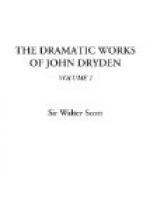[3] Lord Mulgrave wrote the prologue when Settle’s play was first acted at court; Lord Rochester’s was written for the second occasion; both were spoken by the beautiful Lady Elizabeth Howard.
[4] See this offensive dedication in the account of Settle’s controversy with Dryden.
[5] A copy of this rare edition (the gift of my learned friend, the Rev. Henry White of Lichfield) is now before me. The engravings are sufficiently paltry; and had the play been published even in the present day, it would have been accounted dear at two shillings. The name of the publisher is William Cademan, the date 1673. [See H. Morley, “English Plays,” pp. 351, 352.—ED.]
[6] This title is omitted in subsequent editions.
[7] Of whom it was said, that he spoke “to the tune of a good speech.”
[8] As, for example, this stage-direction: “Here a company of villains in ambush from behind the scenes discharge their guns at Muly-Hamet; at which Muly-Hamet starting and turning, Hametalhaz from under his priest’s habit draws a sword and passes at Muly-H., which pass is intercepted by Abdeleader. They engage in a very fierce fight with the villains, who also draw and assist Hametalhaz, and go off several ways fighting; after the discharge of other guns heard from within, and the clashing of swords, enter again Muly-Hamet, driving in some of the former villains, which he kills.”
[9] In the fifth act the scene draws and discovers Crimalhaz cast down on the guanches, i.e. hung on a wall set with spikes, scythe-blades, and hooks of iron; which scene (to judge from the engraving) exhibited the mangled limbs and wasted bones of former sufferers, suspended in agreeable confusion. With this pleasing display the piece concluded.
[10] Settle’s pamphlet was contumaciously entitled, “Notes and Observations on the Empress of Morocco revised, with some few erratas; to be printed instead of the Postscript with the next Edition of the Conquest of Granada, 1674.” See some quotations from this piece, vol. xv.




